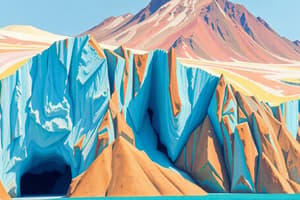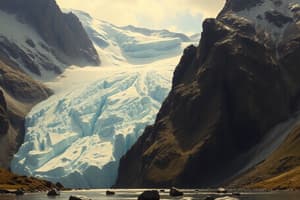Podcast
Questions and Answers
What can occur as a result of overdrawing groundwater in coastal regions?
What can occur as a result of overdrawing groundwater in coastal regions?
- Decreased agricultural productivity
- Sea water intrusion (correct)
- Formation of new aquifers
- Increased groundwater availability
Which process allows glaciers to slide as they melt from the bottom?
Which process allows glaciers to slide as they melt from the bottom?
- Surface fracturing
- Lateral flow
- Thermal expansion
- Basal sliding (correct)
What type of glacier is found in mountainous regions and can create hanging valleys?
What type of glacier is found in mountainous regions and can create hanging valleys?
- Continental glacier
- Alpine glacier (correct)
- Tidewater glacier
- Piedmont glacier
What phenomenon occurs when land sinks as a result of overdrawing groundwater?
What phenomenon occurs when land sinks as a result of overdrawing groundwater?
Which of the following is a feature created by glaciers as they deposit sediment and rocks?
Which of the following is a feature created by glaciers as they deposit sediment and rocks?
What occurs when the accumulative effects of ice formation exceed melting on a glacier?
What occurs when the accumulative effects of ice formation exceed melting on a glacier?
Which process involves the breaking away of rocks due to melting and refreezing of glacier ice?
Which process involves the breaking away of rocks due to melting and refreezing of glacier ice?
What is the primary outcome of the process known as abrasion?
What is the primary outcome of the process known as abrasion?
What term is used to describe the unsorted materials deposited by glaciers?
What term is used to describe the unsorted materials deposited by glaciers?
What characterizes a cirque in glacial geography?
What characterizes a cirque in glacial geography?
What process describes the sinking of the earth's crust due to weight from glaciers?
What process describes the sinking of the earth's crust due to weight from glaciers?
Which phenomenon explains the variations in the earth's position that affect the amount of solar radiation received?
Which phenomenon explains the variations in the earth's position that affect the amount of solar radiation received?
What type of coastlines emerge from tectonic activity and are characterized by steep, rocky cliffs?
What type of coastlines emerge from tectonic activity and are characterized by steep, rocky cliffs?
What are the inactive underwater volcanoes that rise over 3,200 feet known as?
What are the inactive underwater volcanoes that rise over 3,200 feet known as?
In which ocean basin is the oceanic ridge system found?
In which ocean basin is the oceanic ridge system found?
What type of margin is characterized by high tectonic and seismic activity?
What type of margin is characterized by high tectonic and seismic activity?
What type of coastlines may develop when wide river valleys become submerged?
What type of coastlines may develop when wide river valleys become submerged?
What is the process called when two tectonic plates collide, forcing one to slide over the other?
What is the process called when two tectonic plates collide, forcing one to slide over the other?
What primarily determines the density of ocean water?
What primarily determines the density of ocean water?
Which of the following statements about ocean waves is true?
Which of the following statements about ocean waves is true?
What effect do high tides have on marine life in estuaries?
What effect do high tides have on marine life in estuaries?
During which lunar phase do spring tides typically occur?
During which lunar phase do spring tides typically occur?
Which of the following features is considered a shoreline feature?
Which of the following features is considered a shoreline feature?
What characterizes diurnal tides?
What characterizes diurnal tides?
What is the primary cause of tsunamis?
What is the primary cause of tsunamis?
Study Notes
Groundwater Issues
- Groundwater is essential for drinking water but faces serious environmental problems.
- Problems often go unnoticed and untreated due to groundwater being out of sight.
- Groundwater pollution originates from agriculture, manufacturing, and underground storage tanks.
- Overdrawing groundwater compares to overdrawing a bank account, leading to depletion.
- Aquifers refill slowly; excessive extraction leads to water resource shortages.
- Coastal aquifer overdrawing allows seawater intrusion, contaminating freshwater supplies.
- Subsidence occurs when land sinks from groundwater removal, causing sinkholes or gradual surface degradation.
- Subsidence can damage infrastructure, including buildings, roads, and pipelines.
Glacier Formation and Movement
- Glaciers are massive ice formations that move under the influence of gravity and their weight.
- Two types of glacier movement: internal flow (ice shifting) and basal sliding (melting base).
- Continental glaciers span large regions, such as Antarctica and Greenland; alpine glaciers form in mountainous areas.
- Tidewater glaciers, a type of alpine glacier, flow to the sea and can calve, releasing ice chunks into the ocean.
- Glacial drift includes sediments left by melting glaciers, leading to formations like moraines and kettle lakes.
Glacial Dynamics
- Glaciers grow and shrink due to accumulation (gain) and ablation (loss) of ice and snow.
- Accumulation comes from snowfall, wind-blown snow, or avalanches; ablation occurs from melting, erosion, and calving.
- The glacier's terminus indicates whether it is advancing (more accumulation) or retreating (more ablation).
- Internal plastic deformation allows glaciers to flow; upper layers crack to form crevasses.
- Abrasion and plucking are glacial erosion processes, creating distinct landforms and transporting materials over distances.
Marine Environments
- Marine environments differ from freshwater due to high salt concentrations, which pose challenges for aquatic life.
- Major ocean zones include intertidal, neritic, oceanic, photic (sunlit), aphotic (dark), and benthic (ocean floor).
- Plankton includes phytoplankton (photosynthetic) and zooplankton (animal-like), crucial for marine ecosystems.
- Marine mammals have adaptations for salt water; coastal birds have specific features for shoreline habitats.
Coastal and Shoreline Features
- Shorelines are dynamic areas influenced by tides and waves, leading to features like headlands, beaches, and lagoons.
- Erosion and sedimentation continually reshape shorelines, affecting habitat availability for marine organisms.
- Waves, caused primarily by wind, create energy movement in water, categorized by types such as wind waves, tsunamis, and tidal waves.
Tides and Their Patterns
- Tides are the daily rise and fall of seawater due to gravitational forces from the moon and sun.
- High tides bring important sediments to marine ecosystems; low tides mark their retreat.
- Coastlines may experience semidiurnal (two of each tide) or diurnal (one of each) tidal patterns.
- Spring tides occur during new moons, resulting in extreme tidal ranges, affecting ecosystems significantly.### Tides
- Neap tides occur during the first and last quarter moon phases, resulting in lower-than-normal high and low tides.
- These tides form when the sun and moon are positioned at right angles relative to the Earth's orbit.
Hurricanes
- A hurricane is a powerful tropical cyclone with sustained winds exceeding 74 mph.
- Hurricanes develop over warm ocean water in tropical and subtropical regions, fueled by heat as water vapor rises into a low-pressure core.
- The eyewall, a band of clouds, surrounds the eye, a calm area at the storm's center.
- Wind circulation during hurricanes is counterclockwise in the northern hemisphere and clockwise in the southern hemisphere due to the Coriolis effect.
- Hurricanes progress through stages: tropical disturbance, tropical depression, tropical storm, and hurricane.
- The Saffir-Simpson Scale classifies hurricanes from Category 1 (74-95 mph) to Category 5 (>157 mph), with Category 5 causing catastrophic damage.
- Conditions for hurricane formation include warmth, humidity, and low wind shear. Loss of strength occurs over cooler water or land.
Tsunamis
- A tsunami is a natural disaster characterized by large water displacements towards coastlines, increasing in height and momentum as they enter shallower waters.
- Common causes include earthquakes, underwater landslides, volcanic eruptions, and meteor strikes.
- Tsunamis can profoundly impact local ecosystems, economies, and public health.
- Significant tsunamis of the 21st century include the 2018 Sunda Strait, 2011 Tohoku, and 2004 Indian Ocean tsunamis.
Shoreline and Coastline
- The shoreline is the area where water meets land, while the coastline refers to the edge of landmasses meeting the ocean, typically farther back.
- Coastline ecology is vital, supporting various plant and animal species that thrive in these environments.
- Erosion transforms coastlines over time, influenced by geological composition.
- Plant life along shorelines provides critical habitat and protection for wildlife, as tide pool animals benefit from changing water levels.
Coastal Processes and Erosion
- Coastal erosion is the process of land and beach degradation due to wave and current action.
- Wave refraction causes waves to approach the shore obliquely, facilitating longshore drift, transporting sand and sediment.
- Coastal communities may implement hard stabilization structures like:
- Groins: built at right angles to the shore to maintain beaches.
- Breakwaters: offshore structures creating calm water zones.
- Seawalls: parallel structures protecting coastal properties from wave impacts.
Hard vs. Soft Stabilization
- Hard stabilization includes artificial structures that may disrupt aesthetics and ecosystems.
- Soft stabilization techniques involve adding vegetation or sand to mitigate erosion.
- Beach nourishment replenishes sand lost through erosion, improving beach quality and providing storm protection but comes with high costs and potential ecological risks.
- Relocation of structures away from eroding coastlines is another preventative measure, exemplified by the relocated Cape Hatteras lighthouse.
Earth's Atmosphere
- Earth's atmosphere consists of five layers: troposphere, stratosphere, mesosphere, thermosphere, and exosphere.
- The troposphere, where weather occurs and life exists, is the lowest layer.
- Nitrogen (78%) and oxygen (21%) are the two most abundant gases, with trace amounts of water vapor, argon, carbon dioxide, and others.
- Ozone in the stratosphere protects against harmful UV radiation, while greenhouse gases like methane and carbon dioxide help regulate Earth's temperature.
Solar Radiation
- Solar radiation includes visible, infrared, and ultraviolet wavelengths, essential for Earth's energy supply.
- Incoming solar radiation is measured in kilowatt hours or watts per square meter.
- Visible light ranges from red (longest wavelength) to violet (shortest wavelength), with infrared light below red and ultraviolet above violet.
- This radiation drives energy processes on Earth, despite seasonal changes.
Studying That Suits You
Use AI to generate personalized quizzes and flashcards to suit your learning preferences.
Description
Test your understanding of geological processes related to glaciers and groundwater. This quiz covers topics such as the impacts of groundwater overdraft in coastal areas, types of glaciers, and features formed by glacial activity. Dive into the fascinating interplay between water resources and glaciology.




